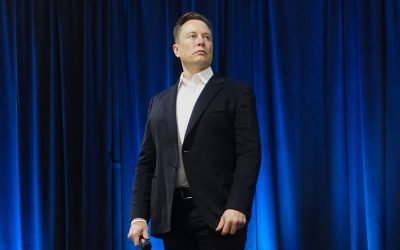An excerpt from Donald Donald and Andrew Greta’s I am John Galt: Today’s Heroic Innovators Building the World and the Villainous Parasites Destroying It (Wiley). “Note the last two paragraphs refer to his death. When the book was written, that event was still in the future.” — Don Luskin
“I don’t intend to build in order to serve or help anyone. I don’t intend to build in order to have clients. I intend to have clients in order to build.”
“How do you propose to force your ideas on them?”
“I don’t propose to force or be forced. Those who want me will come to me.” —The Fountainhead
When Steve Jobs took the stage in October 2001, he was a man resurrected, returned home from a classic hero’s journey, still true to his singular vision, but battle-hardened from 12 years wandering the business wilderness as a castoff from the tribe he founded. He was grayer and leaner, yet still sharp-edged like tempered steel emerging from the fire, himself the sword the journeying hero forges in the great myths.
Or more exactly, here was Howard Roark—Ayn Rand’s brilliant and rebellious architect hero from The Fountainhead—returning to the city to erect a stunning skyscraper embodying his own epoch-making vision, after being forced to labor in a granite quarry merely to survive.
Here was the intransigent individualist who invented a worldwide culture of personal computing, and was unceremoniously ousted from the seat of his creation by collective forces bent on harnessing and diffusing his disruptive vision through committees and opaque corporate processes. Along the way, he had a brush with financial death and went on to revolutionize a second industry—only to be recalled to rescue his original creation from the brink of collapse. Jobs was back to lead the rebirth of Apple Computer, clear the debris left by the collective that had ousted him, and rebuild his masterwork on the solid foundations of his individual vision, as he first had 17 years before.
He was close-cropped, scruffy, and dressed in his now-signature black mock turtleneck and jeans; gone were the suit coat, button-down shirt, bow tie, and boyish mop of hair from his 1984 inaugural Macintosh presentation. Gone, too, were the thematic Chariots of Fire music and talking computer gimmicks amid a cheering auditorium packed with thousands of devotees. Instead, Jobs cast a deep resonating spell of low-key personal charisma—the kind that captures and holds an audience rapt with a mere whisper.
The new uniform was deliberate. On one level, Jobs was subordinating his corporeal body to his visionary creations by shedding props and presentational artifice to allow a clearer focus on the product of his mind. The question was not “What would Steve wear?” but “What revolutionary new idea will he present today?” It was also symbolic of his simplified approach to Apple upon his return as interim CEO in 1997, when he quickly pared the growing number of foundering product groups from 15 down to a focused three while slashing inefficient overhead, laying off employees, and repopulating his board of directors with handpicked replacements, including Larry Ellison of Oracle and former Apple sales head Bill Campbell, then CEO of Intuit.
In his signature presentation style, Jobs began his homecoming pitch to a small assembly of attendees at an Apple Music event. With a relaxed and unhurried ease he spoke of the market, competition, underlying technology, and the recipe for success in leveraging the Apple brand. In a seamless and nearly undetectable transition to aesthetics, he then began describing the design and usability of an entirely new-breed model of music accessibility. As he built to a crescendo, the audience was salivating in suspense. “Durable. Beautiful. And this is what the front looks like. Boom!” he exclaimed. “That’s iPod. And I happen to have one in my pocket.”
Yet the moment had even deeper meaning than the introduction of a cool new product. It was evidence of how Jobs’s entire existence symbolized right and left brains harmonized—analytics and creativity coexisting in a symbiotic blend of productive energy focused on the output of human creation instead of the cumbersome tools used to hammer those ideas into reality. He had spent a lifetime transcending the chasm between silicon-based technology and carbon-based humans. The world called that the “user interface.” To Jobs, it was a barrier, a gap, and his vision was to make that gap seem nonexistent. And now he was doing it again, with a revolutionary product of his unique mind that would transform the popular culture of the world.
He once called the personal computer (PC) “the equivalent of a bicycle to our minds” as a metaphor for human ingenuity’s ability to leverage our physical capabilities beyond anything in the natural world. A person on foot is quickly outpaced by most of the animal kingdom, he would explain. When that same person conceives and designs a set of wheels connected by gears and pedals, he or she becomes the most efficiently self-mobile creature on earth. But just as a bicycle without a rider is a mere hunk of metal, a computer can amplify the intellect only when a human mind is powering it. This interface between mind and machine is where Steve Jobs lives.
According to Apple co-founder Steve Wozniak, “He was never driven by a vision of a better world; he was driven by a vision of himself as a person whose decisions guide the world. He wanted to build a device that moved the world forward, that would take people further. He wanted to build a reality that wasn’t there. He wanted to be one of the important ones. He either likes what he’s looking at or he doesn’t. He’s not concerned with what contribution he’s making. He wants to astound himself, for himself.”
Ayn Rand‘s first great novel, The Fountainhead, was built around such a man, a supreme individualist—or “egoist” in Rand’s terms—Howard Roark. In the words of Roark, “I can find the joy only if I do my work in the best way possible to me. But the best is a matter of standards—and I set my own standards. I inherit nothing. I stand at the end of no tradition. I may, perhaps, stand at the beginning of one.”
He’s been referred to as a charismatic boy wonder, the Alpha Adolescent, a cultural phenomenon, a consumer technology impresario, an adroit chief executive, a cultural revolutionary, a man with three faces, a zealot, the enfant terrible, an arbiter of popular culture, a temperamental micromanager. Yet he is simply an individual—an individual who dares to shape the world in accord with what Roark would call his “unborrowed vision” and his “independent judgment.”
Like Ayn Rand herself, Jobs dares to judge the world in binary terms, in what Rand would call the Aristotelian mode of determining either-or. Products, in his view, are either “insanely great” or “shit.” One is either dying from cancer or “cured.” Subordinates are either geniuses or “bozos,” either indispensable or irrelevant. And like Rand’s iconic individualist Roark, Jobs works for his own reward and satisfaction in his own unbending terms. He returned to lead Apple, accepting a salary of only $1, saying, “The only purpose for me in building a company is so that it can make products.” And like Roark, Jobs doesn’t rely on the opinions of others to define his own views. He has the self-confidence to know that all great ideas throughout history have sprung from the intellect of a single individual. “The mind is an attribute of the individual. There is no such thing as a collective brain,” said Howard Roark.
Jobs doesn’t see himself creating something new as much as he is discovering what others can’t see. Like the myth of Prometheus and his discovery of fire, Steve is constantly surprising the world by meeting the needs and desires that people never knew they had. Comparing Jobs with Polaroid inventor Dr. Edwin Land, former Apple CEO John Sculley said, “Both of them had this ability not to invent products but to discover products. Both of them said these products have always existed—it’s just that no one has ever seen them before. We were the ones who discovered them. The Polaroid camera always existed, and the Macintosh always existed—it’s a matter of discovery.”
Yet for Jobs such discoveries are, of necessity, the discovery of himself. “If I asked someone who had only used a personal calculator what a Macintosh should be like, they couldn’t have told me,” Jobs once explained. “There was no way to do consumer research on it, so I had to go and create it, and then show it to people, and say now what do you think?” Apple marketing chief Mike Murray observed, “Steve did his market research by looking into the mirror every morning.”
Anyone who has ever been curious enough to disassemble an iPod quickly realizes it looks the way it does on the outside because of what’s inside. The economy of space, the use of materials both durable and stylish, the most leading-edge components of the day, the physical layout, and the user interface are all unique to the end function—making software manifest in the physical world while simultaneously making it invisible to the user. In short, Apple products look a certain way because they have to.
According to Sculley, “Steve’s brilliance is his ability to see something and then understand it and then figure out how to put it into the context of his design methodology—everything is design. He’s a minimalist and constantly reducing things to their simplest level. It’s not simplistic. It’s simplified. Steve is a systems designer. He simplifies complexity.”
Or in describing Howard Roark’s architectural design mentor Henry Cameron, “He said only that the form of a building must follow its function; that the structure of a building is the key to its beauty; that new methods of construction demand new forms; that he wished to build as he wished and for that reason only.”
Jobs has spent a lifetime living by Roark’s own singular rulebook not as the designer of buildings, but as the architect of a new approach to technology. Or in Roark’s words, “The purpose, the site, the material determine the shape. Nothing can be reasonable or beautiful unless it’s made by one central idea, and the idea sets every detail. . . . Its integrity is to follow its own truth, its one single theme, and to serve its own single purpose. A man doesn’t borrow pieces of his body. A building doesn’t borrow hunks of its soul. Its maker gives it the soul.”
Someday death will come to him, as it must to all of us. What he’s built for the world will make him an immortal figure in the history of technology and business. But he’s immortal in another sense, in the way that all self-motivated and self-consistent people are—that they don’t die a little bit every day by compromising themselves, that during their lifetimes they truly live.
What a fellow artist said of Howard Roark in The Fountainhead might have been said of Steve Jobs: “I often think he’s the only one of us to achieve immortality. I don’t mean in the sense of fame, and I don’t mean he won’t die someday. But he’s living it. I think he is what the conception really means.”
An edited excerpt from Donald Donald and Andrew Greta’s I am John Galt: Today’s Heroic Innovators Building the World and the Villainous Parasites Destroying It (Wiley). Republished in Capitalism Magazine by permission of the author(s).




